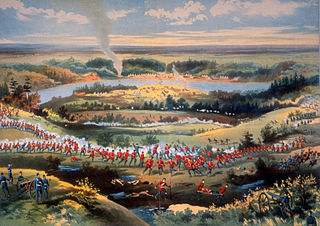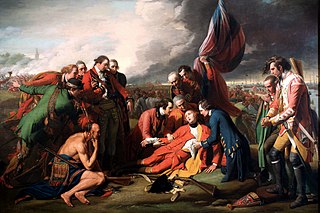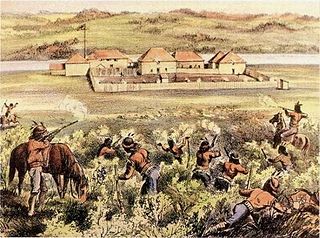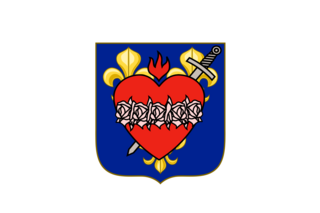
The North-West Rebellion, was an armed rebellion of Métis under Louis Riel and an associated uprising of Cree and Assiniboine mostly in the District of Saskatchewan, North-West Territories, against the Canadian government. Many Métis felt that Canada was not protecting their rights, their land, and their survival as a distinct people. A provisional government led by Louis was declared, and rebel territory carved out, starting on March 18. As government forces responded, fighting broke out, with the last shooting over by the end of June. Important events included the Frog Lake incident, the capture of Batoche in May 1885 and Big Bear's surrender in early July. About 91 people were killed in the fighting that occurred that spring before the conflict ended. Although the Metis were militarily defeated, the Canada government subsequently did modulate some of its policies. Louis Riel was hanged but has since been pardoned for his actions.

Events from the year 1885 in Canada.

The Battle of Cut Knife, fought on May 2, 1885, occurred when a flying column of North-West Mounted Police, Canadian militia, and Canadian regulars attacked a Cree and Assiniboine teepee settlement near Battleford in the North-West Territories' District of Saskatchewan. at the time of the 1885 North-West Rebellion. First Nations fighters forced the Canadian forces to retreat, with losses on both sides.
The Battle of Frenchman's Butte, fought on May 28, 1885, occurred when the Alberta Field Force attacked a force of Cree, dug in on a hillside near Frenchman's Butte. The battlefield is located in what was then the District of Saskatchewan of the North-West Territories, now the province of Saskatchewan.

The North-West Mounted Police (NWMP) was a Canadian paramilitary police force, established in 1873, to maintain order in the new Canadian North-West Territories (NWT) following the 1870 transfer of Rupert's Land and North-Western Territory to Canada from the Hudson's Bay Company, the Red River Rebellion and in response to lawlessness, demonstrated by the subsequent Cypress Hills Massacre and fears of United States military intervention. The NWMP combined military, police and judicial functions along similar lines to the Royal Irish Constabulary. A small, mobile police force was chosen to reduce potential for tensions with the United States and First Nations. The NWMP uniforms included red coats deliberately reminiscent of British and Canadian military uniforms.

Acheson Gosford Irvine, ISO served as Commissioner of the North-West Mounted Police (NWMP) from November 1, 1880, to March 31, 1886.

Batoche, Saskatchewan, which lies between Prince Albert and Saskatoon, was the site of the historic Battle of Batoche during the North-West Rebellion of 1885. The battle resulted in the defeat of Louis Riel and his Métis forces by Major General Frederick Middleton and his Northwest Field Force. Batoche was then a small village of some 500 residents. The site has since become depopulated and now has few residents. The 1885 church building and a few other historic buildings have been preserved, and the site is a National Historic Site.

Poundmaker, also known as Pîhtokahanapiwiyin, was a Plains Cree chief known as a peacemaker and defender of his people, the Poundmaker Cree Nation. His name denotes his special craft at leading buffalo into buffalo pounds (enclosures) for harvest.

The Battle of Duck Lake was an infantry skirmish 2.5 kilometres (1.6 mi) outside Duck Lake, Saskatchewan, between North-West Mounted Police forces of the Government of Canada, and the Métis militia of Louis Riel's newly established Provisional Government of Saskatchewan. The skirmish lasted approximately 30 minutes, after which Superintendent Leif Newry Fitzroy Crozier of the NWMP, his forces having endured fierce fire with twelve killed and eleven wounded, called for a general retreat. The battle is considered the initial engagement of the North-West Rebellion. Although Louis Riel proved to be victorious at Duck Lake, the general agreement among historians is that the battle was strategically a disappointment to his cause.

The Battle of Fish Creek, fought April 24, 1885 at Fish Creek, Saskatchewan, was a major Métis victory over the Canadian forces attempting to quell Louis Riel's North-West Rebellion. Although the reversal was not decisive enough to alter the ultimate outcome of the conflict, it was convincing enough to persuade Major General Frederick Middleton to temporarily halt his advance on Batoche, where the Métis would later make their final stand.

The Battle of Batoche was the decisive battle of the North-West Rebellion, which pitted the Canadian authorities against a force of First Nations and Métis people. Fought from May 9 to 12, 1885, at the ad hoc Provisional Government of Saskatchewan capital of Batoche, the greater numbers and superior firepower of General Frederick Middleton's force eventually overwhelmed the Métis fighters.

Leif Newry Fitzroy Crozier, commonly known as L. N. F. Crozier, was a Canadian Militia officer and a superintendent of the North-West Mounted Police (NWMP), now best remembered for his role in the North-West Rebellion of 1885, a resistance movement headed by Métis leader Louis Riel in what is now the modern province of Saskatchewan.

The Battle of Fort Pitt was part of a Cree uprising coinciding with the Métis North-West Rebellion in 1885. Cree fighters began a series of attacks on Canadian settlements on April 2. On April 15, they captured Fort Pitt from a detachment of North-West Mounted Police.
The Prince Albert Volunteers (PAV) is the name of two historical infantry units headquartered in Prince Albert, Saskatchewan. The unit was first raised in 1885 during the North-West Rebellion and disbanded after hostilities ceased. In the 20th century, the unit was operational from 1913 to 1936 and 1941 to 1946. The PAV is now incorporated by amalgamation in the North Saskatchewan Regiment (N Sask R).

Fort Pitt Provincial Park is a provincial park in the Canadian province of Saskatchewan. It includes the site of Fort Pitt, a trading post built in 1829 by the Hudson's Bay Company (HBC) on the North Saskatchewan River in Rupert's Land. It was built at the direction of Chief Factor John Rowand, previously of Fort Edmonton, to trade goods for bison hides, meat and pemmican. Pemmican, dried buffalo meat, was required as provisions for HBC's northern trading posts.

The Provisional Government of Saskatchewan was an independent state declared during the North-West Rebellion of 1885 in the District of Saskatchewan of the North-West Territories. The name was given by Louis Riel. Although Riel initially hoped to rally the Countryborn, Cree, and European settlers of the Saskatchewan Valley to his banner, this did not occur. The government, with the exception of Honoré Jaxon and Chief White Cap, had an entirely French-speaking and Métis leadership. Gabriel Dumont was proclaimed adjutant general in which capacity he became supreme military commander, although Riel could, and did, override his tactical decisions. The Provisional Government was declared by Riel on March 19, 1885. It ceased to exist following the defeat of the Métis militarily during the Battle of Batoche, which concluded on May 20, 1885. During its existence the government only exercised authority over the Southbranch Settlements along the South Saskatchewan River. Other major centres in the area such as Prince Albert, Saskatoon, and most First Nations reserves remained outside of its control.

The March West was the initial journey of the North-West Mounted Police (NWMP) to the Canadian prairies, made between July 8 and October 9, 1874.

The Looting of Battleford began at the end of March, 1885, during the North-West Rebellion, in the town of Battleford, Saskatchewan, then a part of the Northwest Territories.

The Rocky Mountain Rangers were one of the volunteer militia units raised in Canada's North West in response to the 1885 North-West Rebellion. It was a body of mounted irregulars, mostly cowboys and ranchers from the area around Fort Macleod, the headquarters of the North-West Mounted Police (NWMP) at the base of the foothills of the Rocky Mountains, about 150 miles (240 km) west of Medicine Hat. This unit is not to be confused with the present-day Canadian Army Reserve unit The Rocky Mountain Rangers of Kamloops, British Columbia. Rather, it is the ultimate ancestor of the South Alberta Light Horse (SALH).

The siege of Battleford was a siege during the North-West Rebellion that lasted from 28 March to 26 May, 1885.



















